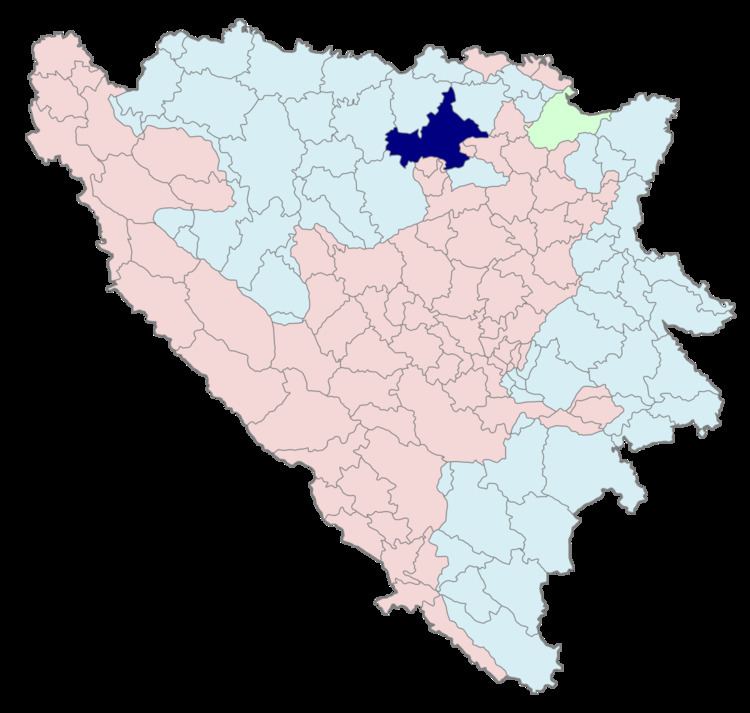 | ||
The Doboj massacre refers to war crimes, including murder, wanton destruction and ethnic cleansing, committed against Bosniaks and Croats in the Doboj area by the Yugoslav People's Army and Serb paramilitary units from April until October 1992 during the Bosnian war. The Research and Documentation Center in Sarajevo registered over 2,300 dead or missing people in the area during the war.
Contents
On 26 September 1997, Nikola Jorgić was found guilty by the Düsseldorf Oberlandesgericht (Higher Regional Court) on 11 counts of genocide involving the murder of 30 persons in the Doboj region, making it the first Bosnian Genocide prosecution. Jorgic's appeal was rejected by the German Bundesgerichtshof (Federal Supreme Court) on 30 April 1999. The Oberlandesgericht found that Jorgic, a Bosnian Serb, had been the leader of a paramilitary group in the Doboj region that had taken part in acts of terror against the local Bosniak population carried out with the backing of the Serb rulers and intended to contribute to their policy of "ethnic cleansing".
Takeover of Doboj in 1992
Doboj was strategically important during the Bosnian War. Before the war, in 1991, the population of the municipality had been 40,14% Bosniak (41.164), 38,83% Serb (39.820), 12,93% Croat (13.264), 5,62% Yugoslav (5.765) and others 2,48% (2.536). The town and surrounding villages were seized by Serb forces in May 1992 with the Serbian Democratic Party taking over the governing of the city. What followed was a mass disarming and mass arrests of all non-Serb civilians (namely Bosniaks and Croats).
Widespread looting and systematic destruction of the homes and property of non-Serbs commenced on a daily basis with the mosques in the town razed to the ground. Many of the non-Serbs who were not immediately killed were detained at various locations in the town, subjected to inhumane conditions, including regular beatings, rape, torture and strenuous forced labour. A school in Grapska and the factory used by the Bosanka company that produced jams and juices in Doboj was used as a rape camp. Four different types of soldiers were present at the rape camps including the local Serbian militia, the Yugoslav army (JNA), police forces based in the Serbian-occupied town of Knin (or "Marticevci" as their commander was Milan Martic) and members of the "White Eagles" (Beli Orlovi) paramilitary group who wore an insignia bearing three eagles and a "kokarda" on their hats.
It has been documented within the United Nations investigations of Doboj, the incarceration of Bosnian and Croat women in a former Olympic stadium housing complex was the site of the mass rapes. Several thousand women of non-Serb origin were systematic raped and abused. Buses from in and around Belgrade brought men to the complex for the purpose of systematic raping of these women. The payment of money for this cruelty was part of the funding process by the various Serb para-military groups operating in the area. It was well known, these paramilitary groups were an extension of the JNA. Many women died at the camp in Doboj due to abuse.
ICTY convictions
In its verdict, the International Criminal Tribunal for the former Yugoslavia stated that Biljana Plavšić and Momčilo Krajišnik, acting individually or in concert with Radovan Karadžić and others, planned, instigated, ordered, committed or otherwise aided and abetted the planning, preparation or execution of the destruction, in whole or in part, of the Bosniak and Bosnian Croat national, ethnical, racial or religious groups, as such, in several municipalities, including Doboj. Plavšić was sentenced to 11 and Krajišnik to 20 years in prison. Plavšić's indictment related to genocide charges in Doboj specifically included but were not limited to the following killings:
Other incidents under investigation include:
In 2011, Jovica Stanišić and Franko Simatović were on trial, among others for war crimes in Doboj.
